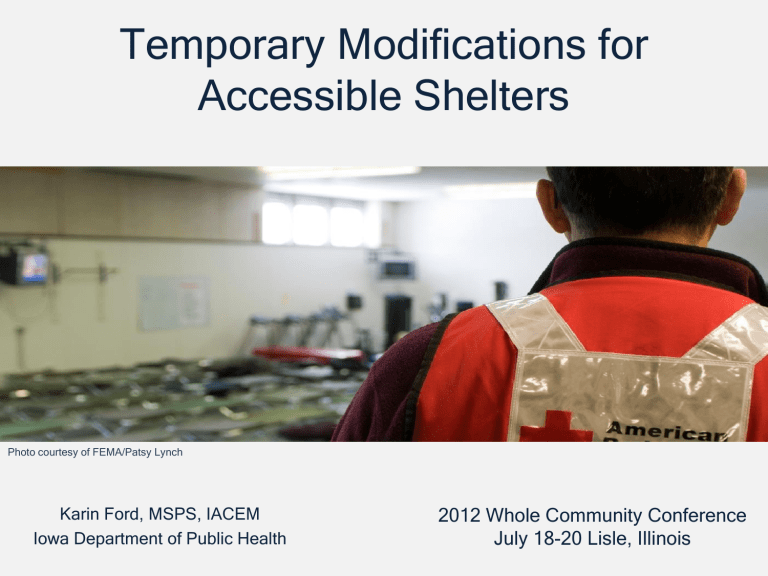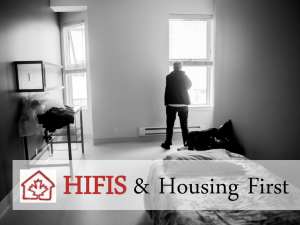PowerPoint

Temporary Modifications for
Accessible Shelters
Photo courtesy of FEMA/Patsy Lynch
Karin Ford, MSPS, IACEM
Iowa Department of Public Health
2012 Whole Community Conference
July 18-20 Lisle, Illinois
Overview
• Understanding emergency management and American’s with Disabilities Act-ADA
• Identifying shelter locations
• Temporary modifications
• Training shelter staff
• Identifying partnerships
Low Hanging Fruit
• Accessible disaster shelter can be achieved
• Provides resource typing
• Creates shelter coalition
• Once established, must be maintained
ADA and Emergency Management
• Emergency management compliance would fall under Title II
• All goods, services programs provided by state and local government, including third parties entities
• This includes Red Cross, faith based and nonprofits
• ADA requires most integrated setting
Shelter Types-Historically
• Mass Care or general population shelters
• Special needs or medical shelters – which are meant to house people who have type or level of care provided by medical personnel, nursing homes, or hospitals
• Typically people with disabilities were sent to these types of shelters
• Accessibility was not top priority for either
Medical Shelters
• Must be staffed with doctors, nurses and trained personnel
• Best case scenario, pre-established transfer locations at same level of care before disaster
• Need medical shelters so hospitals are not overwhelmed
Shelter
• Accessible general population shelters
• Heating and cooling shelters/centers
• Medical shelters
• Pet shelters
Temporary Modifications
• ADA requires most integrated setting
• Temporary modifications for physical accessibility
• Must be readily available
Where to Begin
• Survey current sites for accessibility-follow
DOJ/ADA guidelines
• Categorize accessible to not at all
• Determine is temporary modifications can increase accessibility
• Inventory – know what you have and what you need
Four Main Areas
• Parking
• Entrance
• Common areas
• Bathrooms/shower
• Typical surveys begin out and work in
• Start with bathroom and work out
ADA Compliant Parking
• Most states adopt ADAAG
Number of Accessible Spaces
• 1 to 25 – 1
• 26 to 50 – 2
• 51 to 75 – 3
• 76 to 100 – 4
• 101 to 150 – 5
• 151 to 200 – 6
• 201 to 300 – 7
• 301 to 400 – 8
• 401 to 500 – 9
• 501 to 1000 – 2 percent of total
• 1001 and over – 20 plus 1 for each 100 over 1000
Temporary Shelter Parking
• Three stalls = two accessible
• Use the middle as an access aisle
• Accessible side walk
• Close to entrance
• Flat surface
Temporary Accessible Shelter
Parking
Orange Cone
• Temporary
• Blocks traffic
• Easy to move
Temporary Upright Signage
• Print and laminate
• Post on temporary stand
• Post high enough
Ramps
• Can be temporary
• Must meet ADA specifications
– Not like the photo
• Need Handrails on both sides if
– over 6 inches high
– 72 inches long
• No ski slopes
Entrance
• Exterior doors follow local fire code
• Automatic openers are recommended not required
• 32 inch clear opening
• Sidewalk leading up to 36 inches
• Signage to accessible entrance
• Communication devices must have both visual and audible signals
Common Areas
• Sleeping
• Eating
• All goods and services on one level, unless working accessible elevator
• Signage and warning systems accessible
• Quiet room is desirable
• Path of travel
Adequate Space
• 40 square feet per person
• Generally need 80 square feet for access and functional needs
– Medicots are higher and wider
– Service animals
• Reserve wall space – use for stability, ease of transfer
• Near exit
Bathroom/Shower
• Both need to be accessible
• Toilet – can use riser to meet minimum height of 17 – 19 inches
• Temporary grab bars, must hold up to
250 lbs
• Transfer benches for showers
• Handheld or adjust features
• Purchase insulation for sink pipes at big box stores
• Soap and towels on counters
Temporary Fixtures
Bathroom-Water Closet
Sink
New 2010 Guidelines
• New construction or structural remodeling needs to follow new regulations
• Would include water closet, signs at accessible/inaccessible entrance/exit
• 60% of entrances/exits be accessible
• 1 in every 6 accessible spaces must be van
Service Animals - Dogs
• Been individually trained to do work or perform tasks to mitigate disability
• Must be on harness, leash or tethered unless interferes with work
• Controlled through voice or other device
• Do not need to be registered or show proof
• Can only remove if the service animal posses a threat or is not housebroke
• If asked to take the dog, use the leash not the harness or they will think they are on duty
Photo courtesy of Mary R. Vogt
Service Animals – Miniature Horses
• Generally 24 -34 inches from shoulders
• Weigh between 70 – 100 pounds
• Entities covered by the ADA must modify their policies where reasonable
• Been individually trained to do work or perform tasks
• Must be under control, housebroken
• Will not compromise safety
• Facility can accommodate the type, size, and weight
Service Animals in Shelters
Staff may ask two questions
• Is it required because of a disability
• What work or task has it been trained to preform
• Cannot ask about the person’s disability
• Cannot require medical documentation, special identification card or training documentation
• Or ask the dog demonstrate its ability to perform the work or task
Training Shelter Staff
• Understand the anatomy of a disaster
• Incident Command
• National Incident Management System
• How to support people with access and functional needs in the shelter
• Personal/family preparedness
• Donations management
Resources
• Maintain a resource list for assistive technology, durable medical equipment, consumable medical goods, medications
• Within the area and out
• Identify needs at intake and send to logistics
• Partner with community providers
I Wish It Were This Easy
Take Away
• Stop planning for disability specific
• Plan using the access and functional needs approach
• Establish partnerships with providers
• Educate each other
• Everyone has something to offer
How Am I Going To Remember All This?
• ADA Homepage has toolkits and checklists http://ada.gov/shleterck.htm
• FNSS Guidance
• Department of Justice technical assistance
(800) 514-0301 voice
• Call me
Contact Information
Karin Ford, MSPS, IACEM
Iowa Department of Public Health
Lucas State Office Building
321 E. 12 th Street
Des Moines, Iowa 50317-0075
515-242-6336
Karin.Ford@idph.iowa.gov











